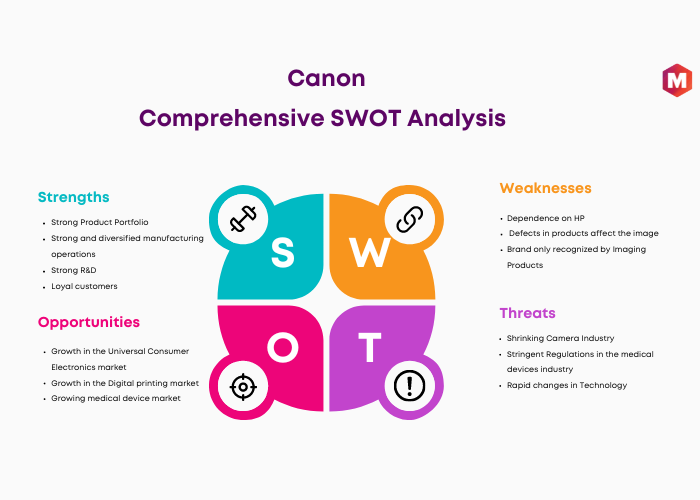Let’s explore the SWOT analysis of Canon by understanding its strengths, weaknesses, opportunities, and threats.
Canon Inc. is a Japanese multinational company and one of the world’s largest manufacturers of imaging and optical products like multifunction devices (MFDs), Flat Panel Displays (FPDs), etc. Canon has been increasing its overseas production and utilizing local components to reduce exchange rate threats. Canon has maintained an operational margin of over 9 percent over the past three years.
Logo:

Overview of Canon:
- Industry: Electronics
- Founded: 10 August 1937; 86 years ago (as Precision Optical Industry Co. Ltd. [???????, Seikik?gakukenky?sho]) Tokyo, Japan
- Founder: Goro Yoshida, Saburo Uchida, Takeo Maeda
- Headquarters: Shimomaruko, ?ta, Tokyo, Japan
- Area served: Worldwide
- Key people: Fujio Mitarai (Chairman & CEO)
Table of Contents
SWOT Analysis of Canon
Strengths of Canon
1. Strong Product Portfolio
Canon has different consumer offerings based on differences in consumer segments. The diverse product portfolio includes office MFDs, laser printers, laser MFPs, digital production printers, etc. The diversity in a portfolio allows the company to target specific segments and reduces the risk of overdependence on single segments.
2. Strong and diversified manufacturing operations
Canon has been focusing on in-house manufacturing facilities in its various global markets. Besides Japan, Canon has manufacturing facilities in 18 different countries. This allows them to improve quality and reduce costs. This also allows them efficiency in operations.
3. Strong R&D
Canon is one of the companies looking to innovate continuously and evolve. Its vital R&D facilities allow it to develop disruptive products in all its segments and categories. The strong R&D helped build strong intellectual property, as Canon received various patents for its innovations.
4. Loyal customers
Canon enjoys a rich history of effective marketing campaigns and superior performance, creating a strong brand image for the company. This has also helped Canon in garnering a loyal base of customers.
5. Fantastic brand valuation
Canon is valued at a whopping $40 billion, making it one of the world’s top 500 most valued brands.
Weaknesses of Canon
1. Dependence on HP
HP is one of the biggest clients of Canon’s laser printers, generating about 18 percent of Canon’s consolidated sales. Although this is a significant strength of canon, the phrase “your best friend is your worst enemy” comes to mind. Termination of this contract can affect Canon’s bottom line.
2. Defects in products affect the image
Canon, known for superior performance, has also faced controversies regarding product defects. For instance, Canon acknowledged defects in Rebel T6s and T6I DSLRs in 2015. This affects the brand image and trust in the company.
3. Brand only recognized by Imaging Products
Canon is famous worldwide for its imaging products, such as cameras, but its other products, such as projectors, are not so popular. Hence, there is a lack of recognition and awareness.
Opportunities of Canon
1. Growth in the Universal Consumer Electronics market
The consumer electronics market is expected to grow at a CAGR of more than 2.5 percent during 2015-2020. Emerging markets primarily drive this and increase household income levels.
2. Growth in Digital printing market
The market for digital printing is expected to grow from $130 bn in 2013 to $290 bn in 2020. Inkjet will also be a major contributor to the segment. This provides a positive outlook for Canon in the future.
3. Growing medical device market
There is continuous growth in the world’s medical device business, which helps the company’s strategy to grow in the medical device industry. This will help the company to expand its product portfolio and market share.
Threats of Canon
1. Shrinking Camera Industry
The Camera Industry is shrinking due to the evolution of mobile phone cameras, which has affected Canon’s camera division sales.
2. Stringent Regulations in the medical devices industry
The medical devices industry is susceptible to stringent and different regulations in different countries. This increases the compliance costs and affects profitability.
3. Rapid changes in Technology
The company has to maintain its speed with the changes in technology. This requires a considerable investment in R&D and increases Canon’s costs.
Conclusion
Canon Inc. is a dominant player in the imaging and optical products sector thanks to its broad production, extensive R&D, and a strong brand worth $40 billion. Despite problems such as reliance on significant clients and quickly changing technology, Canon is well-positioned for expansion, with potential in consumer electronics and the medical device industry. Its dedication to innovation and quality keeps it robust amid industry changes and regulatory challenges.
Liked this post? Check out the complete series on SWOT

